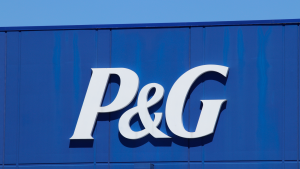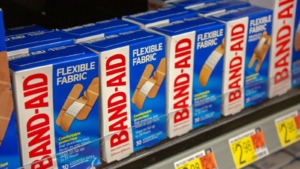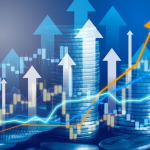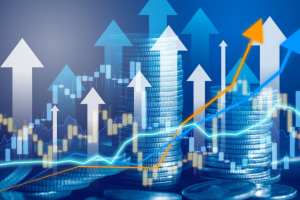
At first glance, the proposal to dive into safe stocks to buy might appear overly conservative. As NPR recently pointed out, the U.S. GDP grew 4.9% in the third quarter, catalyzed by stronger-than-expected consumer spending. While stunning, the good times might not last.
For one thing, experts warn that the economy is unlikely to sustain the current blistering pace. In particular, higher interest rates – which obviously impose elevated borrowing costs – may crimp upside. Pointing to the slowdown in the real estate market, NPR noted that the expenditures in other industries may likewise decline.
Another issue that raises skepticism on the perma-bull narrative –and thus warranting a close look at safe stocks to buy – is the domino effect. With fewer people buying big-ticket items (which is clearly the case with the electric vehicle sector fallout), many companies involved in the affected value chain must tighten their belts.
Subsequently, this development may lead to mass layoffs, which has already been happening. So, don’t be too quick to jump on the hyper-bullish bandwagon. Instead, these safe stocks might offer a more balanced compromise.
Safe Stocks: Procter & Gamble (PG)

One of the least volatile securities available, Procter & Gamble (NYSE:PG) shares feature a 60-month beta of 0.47. In contrast, a beta of 1 indicates a magnitude of volatility that matches that of the benchmark equities index. Stated differently, you’re not going to find much excitement wagering on PG stock. However, it should keep the ship upright, even during times of trouble.
A consumer goods manufacturing giant, P&G is effectively a permanently relevant business. With always-needed products and a storied brand reputation, it’s a great idea if you want to stay in the market but in a conservative manner. While PG might not be the cheapest of the blue chips out there (trading at a somewhat lofty 24.5X trailing earnings multiple), it’s consistently profitable.
Unsurprisingly, the company rewards its shareholders via a forward dividend yield of 2.49%. Also, it enjoys 67 years of consecutive dividend increases. Analysts rate PG a moderate buy with a $163.44 average price target.
American Water Works (AWK)

At the moment, shares of American Water Works (NYSE:AWK) don’t appear a reasonable idea for safe stocks to buy. Since the beginning of the year, AWK lost a hefty amount of equity value. That said, it’s been moving conspicuously higher in recent sessions. Also, it’s important to point out that AWK features a 60-month beta of 0.63. Historically, it’s just not that volatile.
Fundamentally, American Water makes a solid case for safe stocks to consider. Per its public profile, the company specializes in water and waste water services to approximately 1,700 communities in 14 states. Overall, AWK serves a population of about 14 million through 3.4 million customer connections. With utilities leveraging a natural monopoly, American Water offers permanent relevance.
Similar to its peers, its financials aren’t exactly pretty. However, it posts robust profit margins and consistently prints positive figures on the bottom line. Subsequently, American Water carries a forward yield of 2.22%. Analysts peg shares a moderate buy with a $138.40 price target.
Safe Stocks: Kroger (KR)

A retail company that operates supermarkets and multi-department stores, Kroger (NYSE:KR) arguably makes a no-brainer case for safe stocks. In particular, I’m anticipating a consumer spending pivot based on the trade-down effect. As financial pressures build, consumers may elect to cook at home rather than eating out at fancy restaurants. Plus, the savings can get quite addictive.
Notably, KR stock runs a 60-month beta of 0.50. That’s not surprising. While it hasn’t performed remarkable well this year, over the past five years, KR returned more than 40% to shareholders. On the financial side, what really sticks out is its forward earnings multiple of only 10.11X. In contrast, the sector median comes in at 14.32X.
Also, Kroger enjoys a predictable revenue trek and consistent profitability. Ultimately, this translates to a forward dividend yield of 2.57%. While not overly generous, the payout ratio sits at 26.42%, implying high confidence for yield sustainability. Analysts rate KR a moderate buy with a $52.75 price target.
Berkshire Hathaway (BRK-B)

I’ve been talking a lot about Warren Buffett lately. Why not include the Oracle of Omaha’s company in this list of safe stocks to buy. We’ll stick with the Class B Berkshire Hathaway (NYSE:BRK-B) shares since I’m not entirely sure how many of my readers have over half-a-million dollars to spend on one share of one stock. Regardless, BRK.B should give us viable exposure to the market.
As a multinational conglomerate, Berkshire is involved in everything thanks to its holdings. Per its public profile, the company’s main business and source of capital is insurance. From there, it invests the float in a broad portfolio of subsidiaries, equity holdings and other securities. Overseen by Buffett and Vice Chairman Charlie Munger, Berkshire runs on the experience of folks who’ve seen it all.
True to form, Berkshire enjoys a strong net margin of 21.63%. Also, BRK-B trades at 8.83x trailing earnings, below the sector median 11.39x. However, it doesn’t pay a dividend. Analysts peg shares a moderate buy with a $410 price target.
Safe Stocks: Merck (MRK)

When it comes to choosing safe stocks to buy, you can’t go wrong with major pharmaceuticals. No matter what happens in the economy, people will always need medical care. On that note, Merck (NYSE:MRK) deserves a closer look. Producing a range of medicines, vaccines, biologic therapies and animal health products, the company offers exceptional relevance.
Thanks to its enduring business, MRK symbolizes one of the least volatile securities. With a 60-month beta of 0.37, investors have the confidence that over time, any red ink will eventually turn black. Therefore, the slip up since the beginning of the year for MRK shouldn’t be a big deal for patient investors. Indeed, the market prices Merck at a forward earnings multiple of 12.33x, below the sector median 14.84X.
Additionally, Merck enjoys solid profit margins and long-term revenue and EBITDA growth. These attributes contribute to the company’s forward yield of 2.8%. As well, the payout ratio sits comfortably at 34.72%. Analysts rate MRK as a strong buy with a $126.67 price target.
Kenvue (KVUE)

A spinoff from healthcare giant Johnson & Johnson (NYSE:JNJ), Kenvue as a separate entity focuses on the consumer health segment. From a fundamental perspective, that makes KVUE quite valuable as one of the safe stocks to buy. With product brands such as Aveeno, Band-Aid and Benadryl under its belt, Kenvue should enjoy consistent and predictable demand.
For example, we don’t know what the big medical breakthrough may be. However, it’s a guarantee that someone, somewhere will get a boo-boo, which would cynically benefit Band-Aid sales. In addition, Kenvue products are relatively cheap and accessible. So, it’s probably not an entity that will make you rich. However, it should keep your portfolio pointed in the right direction.
While Kenveue will need to improve certain financial metrics, it posts strong gross and operating margins. As well, the company offers a forward yield of 4.13% (though the payout ratio is a bit elevated at 62.4%). Lastly, analysts peg KVUE a moderate buy with a $24.89 price target.
MetLife (MET)

Perhaps the most boring enterprise on this list, MetLife (NYSE:MET) is one of the world’s largest providers of insurance, annuities and employee benefit programs. Per its public profile, MetLife commands about 90 million customers across 60 countries. Primarily, it focuses on life insurance, which should see a lift in demand due to the Covid-19 crisis.
Basically, the free world got a huge reality check with the SARS-CoV-2 virus. Anything can happen in our interconnected world so it pays to have our financial house in order. While it offers relevance, prospective investors should note that its 60-month beta runs a bit high at 1.06. No, it’s not alarming but it’s down conspicuously over the past 52 weeks.
For contrarians, it’s possible the red ink may represent a discounted opportunity. Shares trade at only 6.63X forward earnings, below the sector median 9.45X. Also, the company offers a forward yield of 3.44% (with an ultra-low payout ratio of 22.45%).
Finally, analysts rate MET a strong buy with an average price target of $78.25.
On the date of publication, Josh Enomoto did not have (either directly or indirectly) any positions in the securities mentioned in this article. The opinions expressed in this article are those of the writer, subject to the InvestorPlace.com Publishing Guidelines.







